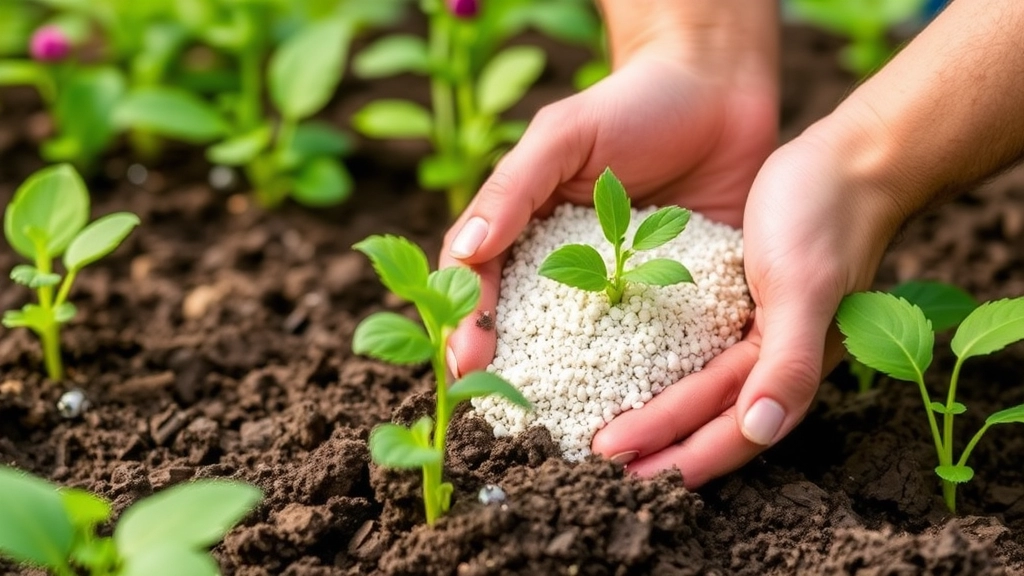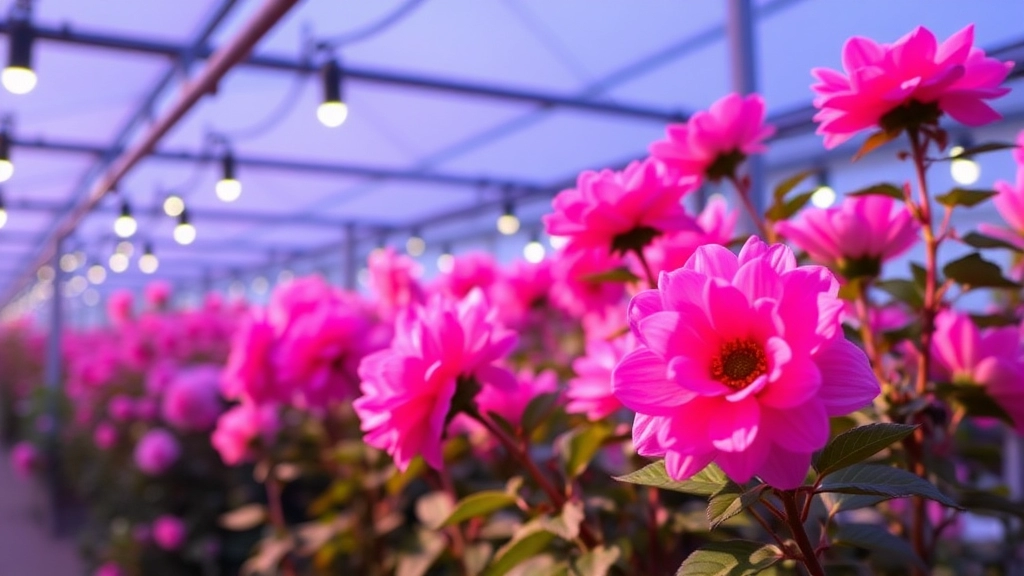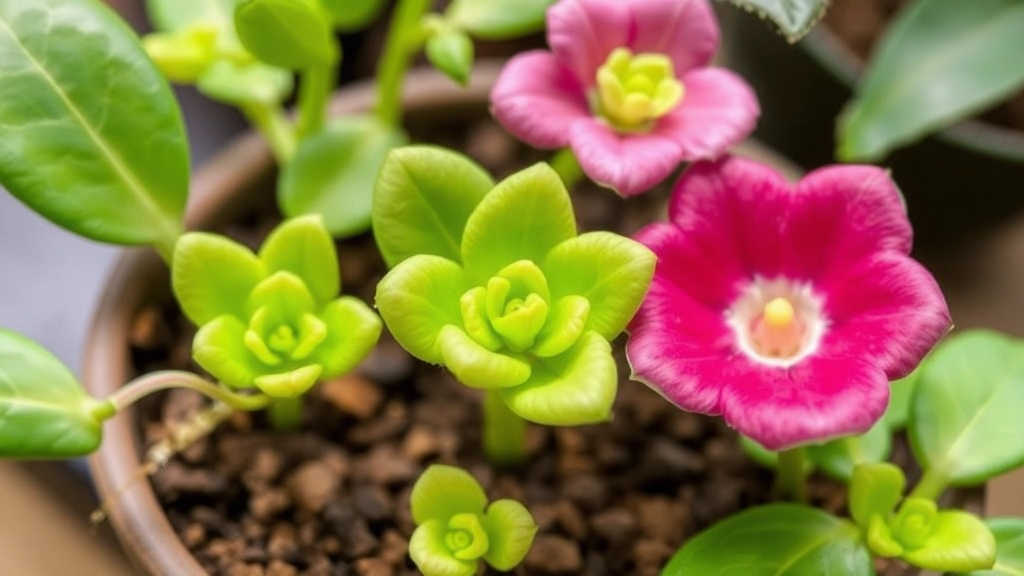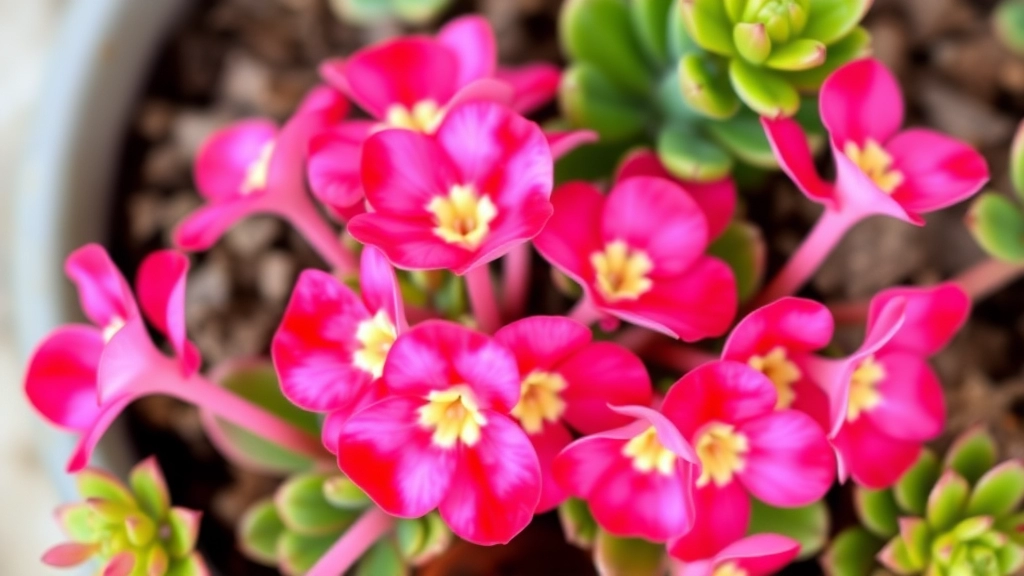Flowering Kalanchoe Succulents
Flowering Kalanchoe Succulents are a stunning addition to any home, thanks to their vibrant blooms and easy-care nature. To keep your kalanchoe thriving, it’s essential to understand its specific care requirements. From the right soil mix to perfect watering practices, I’ll guide you through everything you need to know to ensure your plant flourishes.
Care Requirements
Getting the light and temperature just right is crucial for your kalanchoe to bloom. I’ll share tips on how to create the ideal environment, prevent common pests, and even propagate your plant using cuttings, offsets, and seeds.
Topics to Explore
- Creating the Ideal Environment
- Preventing Common Pests
- Propagation Techniques
Let’s dive into the world of Flowering Kalanchoe Succulents and make your indoor garden a blooming success.
Are you struggling to keep your flowering Kalanchoe thriving? You’re not alone. Many plant enthusiasts face challenges in nurturing these beautiful succulents. However, understanding their optimal care requirements can transform your gardening experience.
## Key Care Requirements
To ensure your Kalanchoe flourishes, consider these essential care guidelines:
– **Watering Routine**: Kalanchoe prefers a thorough watering when the soil is completely dry. Overwatering can lead to root rot, so it’s crucial to strike the right balance.
– **Soil Type**: A well-draining soil mix is vital. Use a cactus or succulent blend, or create your own by mixing potting soil with sand or perlite.
– **Temperature and Humidity**: Kalanchoe thrives in temperatures between 18°C to 24°C. Keep them in a location with low humidity to prevent fungal issues.
– **Light Exposure**: These plants love bright, indirect sunlight. Position them near a window but avoid direct afternoon sun to prevent leaf scorch.
– **Fertilization**: During the growing season, a balanced, water-soluble fertilizer can promote vibrant blooms. Fertilise every 4-6 weeks for optimal results.
For more detailed information on how to grow and care for Kalanchoe, check out our [complete care guide for Kalanchoe blossfeldiana succulent](https://planthq.org/complete-care-guide-for-kalanchoe-blossfeldiana-succulent/). Additionally, if you’re interested in the specific requirements of different Kalanchoe varieties, you might find our [types of Kalanchoe tomentosa varieties and care tips](https://planthq.org/types-of-kalanchoe-tomentosa-varieties-and-care-tips/) particularly useful.
Best Soil and Fertilizer Practices for Healthy Growth

So, you’ve got your Kalanchoe, and now you’re wondering about the best soil and fertilizer to keep it thriving, right?
Let’s dive into it!
Choosing the Right Soil
Kalanchoe plants are succulents, and they love well-draining soil. Here’s what you should consider:
- Cactus Mix: A pre-made cactus or succulent mix is a solid choice. It allows for proper drainage.
- DIY Mix: Want to get hands-on? Mix regular potting soil with perlite or sand (about 2:1 ratio). This ensures good aeration and drainage.
- pH Level: Aim for a slightly acidic to neutral pH (around 6.0 to 7.0).
Fertilizer Tips
Now that we’ve got the soil sorted, let’s talk about feeding your Kalanchoe:
- Frequency: During the growing season (spring and summer), fertilize every 4-6 weeks. In the fall and winter, cut back, as the plant goes dormant.
- Type of Fertilizer: Use a balanced, water-soluble fertilizer. Look for something like a 10-10-10 NPK mix.
- Dilution: Always dilute the fertilizer to half strength to avoid burning those lovely roots.
A Quick Checklist
- Soil: Well-draining cactus mix or DIY mix with perlite/sand.
- Fertilizer: Balanced, water-soluble, diluted to half strength.
- Schedule: Every 4-6 weeks in spring/summer; less in winter.
How to Water Your Kalanchoe Succulent Correctly
Many plant enthusiasts often wonder how to properly water their Kalanchoe succulents. Overwatering or underwatering can lead to various issues, including root rot or dehydration.
To ensure your Kalanchoe thrives, consider the following watering tips:
- Frequency: Water your Kalanchoe every two to three weeks during the growing season (spring and summer). In the dormant months (autumn and winter), reduce watering to once a month.
- Soil Check: Always check the top inch of soil before watering. If it feels dry, it’s time to water. If it’s still moist, wait a few more days.
- Watering Technique: When you do water, do so thoroughly. Pour water until it drains out of the bottom of the pot. This ensures that the roots receive adequate moisture.
- Drainage: Ensure your pot has drainage holes. This prevents excess water from sitting at the bottom, which can cause root rot.
- Water Quality: Use room temperature water. Cold water can shock the plant, while distilled or rainwater is ideal for avoiding chemical buildup.
- Signs of Trouble: Keep an eye out for signs of overwatering, such as yellowing leaves or mushy stems. Conversely, if the leaves are shriveling or dropping, it may need more water.
By following these simple guidelines, you can maintain the health and vibrancy of your Kalanchoe. For more detailed care tips, check out our watering best practices and complete care guide for Kalanchoe Tomentosa.
Light and Temperature Conditions for Maximum Blooms

Are you struggling to get your Kalanchoe to bloom?
The right light and temperature conditions are crucial for encouraging those vibrant flowers.
Optimal Light Conditions
Kalanchoe succulents thrive in bright, indirect sunlight.
- Location: Place your plant near a south or west-facing window.
- Duration: Aim for at least 6 hours of light daily.
- Avoid Direct Sun: Too much direct sunlight can scorch the leaves.
If you’re noticing leggy growth, it’s a sign your plant isn’t getting enough light.
Temperature Preferences
Temperature plays a significant role in blooming as well.
Kalanchoe prefers:
- Daytime Temperatures: Between 20°C to 24°C (68°F to 75°F).
- Nighttime Temperatures: A drop to 15°C to 18°C (59°F to 65°F) is ideal.
Avoid exposing your plant to cold drafts or sudden temperature changes.
Seasonal Considerations
In winter, your Kalanchoe may need a bit more care:
- Indoor Placement: Keep it indoors to protect it from frost.
- Light Adjustment: Ensure it gets enough light during shorter days.
As you nurture your flowering Kalanchoe, you may encounter some common pests that can threaten its health and vibrancy.
### Common Pests
– **Mealybugs**
These small, white, cottony insects often hide in leaf joints and under leaves.
– **Spider Mites**
Tiny and often invisible to the naked eye, they create fine webs and cause leaf discoloration.
– **Aphids**
These green or black insects cluster on new growth, sucking sap and weakening the plant.
– **Scale Insects**
They appear as small, brown bumps on stems and leaves, feeding on the plant’s sap.
### Prevention Tips
To keep your Kalanchoe thriving, consider these straightforward preventive measures:
– **Regular Inspection**
Check your plant weekly for any signs of pests. Early detection is key.
– **Maintain Good Air Circulation**
Ensure your Kalanchoe is not overcrowded with other plants, allowing air to flow freely.
– **Proper Watering**
Overwatering can attract pests. Make sure your succulent is not sitting in water.
– **Use Neem Oil**
A natural pesticide, neem oil can deter pests without harming your plant.
– **Keep Leaves Clean**
Wipe leaves with a damp cloth to remove dust and deter pests.
– **Quarantine New Plants**
Always isolate new plants for a few weeks to prevent introducing pests to your collection.
For more detailed care tips, you might find our [complete guide for flowering Kalanchoe Blossfeldiana](https://planthq.org/how-to-grow-and-care-for-flowering-kalanchoe-blossfeldiana/) helpful. Additionally, understanding the [ideal temperature for Kalanchoe Blossfeldiana growth](https://planthq.org/ideal-temperature-for-kalanchoe-blossfeldiana-growth/) can also contribute to a pest-free and healthy plant.
Propagation Methods: Cuttings, Offsets, and Seeds

So, you’ve got a beautiful Kalanchoe and want to multiply that joy? Propagation is a fantastic way to expand your collection or share with friends.
Cuttings
This is probably the easiest method. Here’s how to do it:
- Select a healthy stem: Look for a plump, green stem.
- Cut it off: Use sterilised scissors to make a clean cut. Aim for about 4-6 inches long.
- Let it dry: Place the cutting in a dry spot for a day or two. This helps to form a callus, which reduces the risk of rot.
- Plant it: Put it in well-draining soil and water sparingly.
Offsets
Kalanchoe often produces offsets, or “pups,” which are little plants that grow at the base. Here’s how to propagate them:
- Identify offsets: Look for small plants attached to the main one.
- Gently separate: Use your hands or a small tool to carefully detach them.
- Plant: Place them in their own pots with the same soil mix.
Seeds
While not the most common method, growing from seeds can be fun if you’re feeling adventurous:
- Get seeds: Purchase them or collect from your existing plants.
- Sow: Sprinkle them on the surface of moist soil. Don’t bury them too deep; they need light to germinate.
- Keep moist: Mist them regularly until they sprout.
Remember, each method has its charm. Cuttings are quick, offsets are simple, and seeds are rewarding.
Tips to Encourage Reblooming in Kalanchoe Plants
After ensuring your Kalanchoe is thriving, you might wonder how to coax it into producing those stunning blooms again. Reblooming can be a delightful challenge, but with the right approach, it’s entirely achievable.
- Prune After Blooming: Once the flowering period is over, trim back the spent flowers and any leggy growth. This encourages the plant to focus its energy on new growth rather than maintaining old blooms. For more details, check out this guide on Kalanchoe blossfeldiana flowering period care tips.
- Adjust Light Exposure: Kalanchoe thrives in bright, indirect sunlight. If your plant has been in low light, consider moving it to a brighter location. However, avoid direct sunlight, which can scorch the leaves.
- Control Watering: During the rest period, reduce watering. Allow the soil to dry out between waterings. This mimics the plant’s natural cycle and encourages it to prepare for the next blooming phase.
- Fertilize Wisely: Use a balanced, water-soluble fertilizer every 4-6 weeks during the growing season. A high-phosphorus fertilizer can be particularly beneficial, as it promotes flower development.
- Temperature Management: Kalanchoe prefers temperatures between 15-25°C (59-77°F). Keeping the plant in this range will help stimulate blooming. A cooler period at night can also encourage flower formation. Learn more about the ideal temperature for Kalanchoe blossfeldiana growth.
- Be Mindful of Dormancy: Kalanchoe typically goes through a dormant phase after blooming. Respect this period by allowing it to rest without excessive watering or fertilising. This rest is crucial for future blooms.
- Encourage a Dark Period: To trigger blooming, provide a period of darkness for at least 12-14 hours a day for about six weeks. This mimics the natural seasonal changes that signal the plant to bloom.
By following these tips, you can help your Kalanchoe thrive and reward you with a second round of vibrant flowers.
FAQs on Flowering Kalanchoe Succulents
What type of soil is best for Kalanchoe succulents?
Kalanchoe plants thrive in well-draining soil. You can use a pre-made cactus or succulent mix, or create a DIY mix by combining regular potting soil with perlite or sand in a 2:1 ratio. Aim for a slightly acidic to neutral pH, around 6.0 to 7.0.
How often should I fertilize my Kalanchoe?
During the growing season (spring and summer), fertilize your Kalanchoe every 4-6 weeks. In the fall and winter, reduce the frequency as the plant goes dormant. Always use a balanced, water-soluble fertilizer diluted to half strength to avoid root burn.
What light conditions do Kalanchoe succulents need?
Kalanchoe succulents thrive in bright, indirect sunlight. Place them near a south or west-facing window and ensure they get at least 6 hours of light daily. Avoid direct sunlight as it can scorch the leaves.
What are the ideal temperature conditions for Kalanchoe?
Kalanchoe plants prefer daytime temperatures between 20°C to 24°C (68°F to 75°F) and nighttime temperatures between 15°C to 18°C (59°F to 65°F). Avoid exposing them to cold drafts or sudden temperature changes.
How can I propagate my Kalanchoe succulent?
You can propagate Kalanchoe through cuttings, offsets, or seeds. For cuttings, select a healthy stem, let it dry to form a callus, and then plant it in well-draining soil. For offsets, gently detach small plants growing at the base and plant them separately. If using seeds, sprinkle them on the surface of moist soil and mist regularly until they sprout.
Why is my Kalanchoe not blooming?
If your Kalanchoe is not blooming, it might not be getting the right light or temperature conditions. Ensure it receives bright, indirect sunlight for at least 6 hours daily and maintain the ideal temperature range. Additionally, make sure to fertilize it during the growing season.
Can I keep my Kalanchoe outdoors?
Kalanchoe can be kept outdoors during warm months but should be brought indoors when temperatures drop, especially in winter. Protect it from frost and ensure it receives enough light during shorter days.
How do I know if my Kalanchoe is getting enough light?
If your Kalanchoe is experiencing leggy growth, it’s a sign that it isn’t getting enough light. Ensure it is placed near a south or west-facing window where it can receive bright, indirect sunlight.
References
-
Gardening Know How: Kalanchoe Plant Care
-
The Spruce: How to Grow and Care for Kalanchoe
-
House Plants Expert: Kalanchoe
